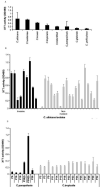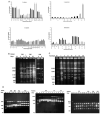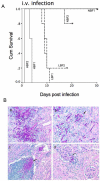Biofilm formation in clinical Candida isolates and its association with virulence
- PMID: 19409507
- PMCID: PMC2715444
- DOI: 10.1016/j.micinf.2009.04.018
Biofilm formation in clinical Candida isolates and its association with virulence
Abstract
Biofilm formation, an important virulence trait of Candida species was measured in 107 Candida isolates from 32 candidemic patients by XTT [2,3-bis (2-methoxy-4nitro-5-sulfo-phenyl)-2H-tetra-zolium-5-carboxanilide] activity and compared to biofilm formation of Candida isolates from oropharyngeal lesions of 19 AIDS patients. Biofilm formation by XTT varied among species and C. albicans; C. lusitaniae and C. krusei produced more biofilm than the other Candida species. C. tropicalis was the most dominant species isolated from blood followed by C. albicans, and other non-albicans species whereas only C. albicans was recovered from oral lesions. Importantly, though Biofilm formation was variable within a species it was stable in sequential isolates during chronic infection. Sequential isolates exhibited identical Karyotype pattern or RAPD patterns unless patients were co-infected with more than one strain. High biofilm formation was associated with slow growth rate but not with adherence. Murine infection studies demonstrated that, degree of in-vitro biofilm formation was associated with virulence in mice, as mice infected both with no and low biofilm formers survived longer than mice infected with high biofilm former C. albicans (p< or =0.001). We conclude that biofilm formation is a stable but strain specific characteristic that can greatly vary among C. albicans and non-albicans strains, and plays an important role in persistence of infection.
Figures




Similar articles
-
Variation in biofilm formation among blood and oral isolates of Candida albicans and Candida dubliniensis.Enferm Infecc Microbiol Clin. 2011 Nov;29(9):660-5. doi: 10.1016/j.eimc.2011.06.009. Epub 2011 Sep 6. Enferm Infecc Microbiol Clin. 2011. PMID: 21899928
-
Biofilm production by isolates of Candida species recovered from nonneutropenic patients: comparison of bloodstream isolates with isolates from other sources.J Clin Microbiol. 2002 Apr;40(4):1244-8. doi: 10.1128/JCM.40.4.1244-1248.2002. J Clin Microbiol. 2002. PMID: 11923339 Free PMC article.
-
[Investigation of the correlation between biofilm forming ability of urinary Candida isolates with the use of urinary catheters and change of antifungal susceptibility in the presence of biofilm].Mikrobiyol Bul. 2016 Apr;50(2):256-65. doi: 10.5578/mb.24248. Mikrobiyol Bul. 2016. PMID: 27175498 Turkish.
-
Adherence and biofilm formation of non-Candida albicans Candida species.Trends Microbiol. 2011 May;19(5):241-7. doi: 10.1016/j.tim.2011.02.003. Epub 2011 Mar 15. Trends Microbiol. 2011. PMID: 21411325 Review.
-
In vitro virulence determinants, comparative pathogenicity of Diutina (Candida) mesorugosa clinical isolates and literature review of the D. rugosa complex.Mycologia. 2019 May-Jun;111(3):395-407. doi: 10.1080/00275514.2019.1585161. Epub 2019 Apr 15. Mycologia. 2019. PMID: 30985256 Review.
Cited by
-
A study on biofilm production and antifungal drug resistance among Candida species from vulvovaginal and bloodstream infections.Infect Drug Resist. 2018 Nov 23;11:2443-2448. doi: 10.2147/IDR.S179462. eCollection 2018. Infect Drug Resist. 2018. PMID: 30538510 Free PMC article.
-
Effect of tetrandrine against Candida albicans biofilms.PLoS One. 2013 Nov 18;8(11):e79671. doi: 10.1371/journal.pone.0079671. eCollection 2013. PLoS One. 2013. PMID: 24260276 Free PMC article.
-
A murine model for catheter-associated candiduria.J Med Microbiol. 2011 Oct;60(Pt 10):1523-1529. doi: 10.1099/jmm.0.026294-0. Epub 2011 May 19. J Med Microbiol. 2011. PMID: 21596904 Free PMC article.
-
Biofilms formed by Candida albicans bloodstream isolates display phenotypic and transcriptional heterogeneity that are associated with resistance and pathogenicity.BMC Microbiol. 2014 Jul 5;14:182. doi: 10.1186/1471-2180-14-182. BMC Microbiol. 2014. PMID: 24996549 Free PMC article.
-
Photodynamic Inactivation Potentiates the Susceptibility of Antifungal Agents against the Planktonic and Biofilm Cells of Candida albicans.Int J Mol Sci. 2018 Feb 1;19(2):434. doi: 10.3390/ijms19020434. Int J Mol Sci. 2018. PMID: 29389883 Free PMC article.
References
-
- Harbarth S, Ferriere K, Hugonnet S, Ricou B, Suter P, Pittet D. Epidemiology and prognostic determinants of bloodstream infections in surgical intensive care. Arch Surg. 2002;137:1353–1359. discussion 1359. - PubMed
-
- Fidel PL., Jr. Candida-host interactions in HIV disease: relationships in oropharyngeal candidiasis. Adv Dent Res. 2006;19:80–84. - PubMed
-
- Blot S, Vandijck D, Vandewoude K. Risk factors for Candida non-albicans candidemia. Diagn Microbiol Infect Dis. 2008 - PubMed
-
- Xess I, Jain N, Hasan F, Mandal P, Banerjee U. Epidemiology of candidemia in a tertiary care centre of north India: 5-year study. Infection. 2007;35:256–259. - PubMed
Publication types
MeSH terms
Grants and funding
LinkOut - more resources
Full Text Sources
Other Literature Sources
Medical
Miscellaneous

